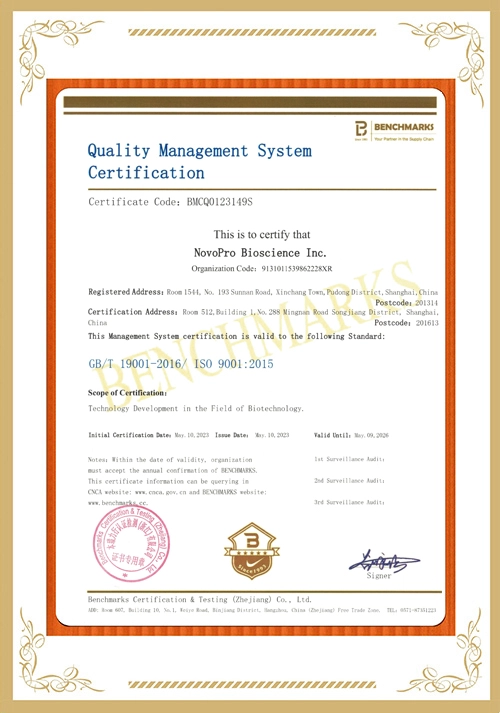Price Information
| Cat No. | Plasmid Name | Availability | Buy one, get one free! (?) |
|---|---|---|---|
| V007487 | pIRES2-DsRed-Express | In stock, instant shipping |
Two tubes of lyophilized plasmid will be delivered, each tube is about 5µg.
Basic Vector Information
pIRES2-DsRed-Express contains the internal ribosome entry site (IRES; 1, 2) of the encephalomyocarditis virus (ECMV) between the MCS and a mutant of the Discosoma sp. red fluorescent protein DsRed-Express coding region (3–5). This permits both the gene of interest (cloned into the MCS) and the DsRed-Express gene to be translated from a single bicistronic mRNA. pIRES2-DsRed-Express is designed for the efficient selection by flow cytometry of transiently transfected mammalian cells expressing DsRed-Express and the protein of interest. This vector can also be used to express DsRed-Express alone or to obtain stably transfected cell lines without timeconsuming drug and clonal selection.DsRed-Express is a human codon-optimized (4) DsRed variant of Discosoma sp. red fluorescent protein (6). Its coding sequence contains nine amino acid substitutions which improve solubility of the protein and reduce the time from transfection to detection of red fluorescence (exitation and emission maxima = 557 nm and 579 nm, respectively). In addition, these substitutions reduce the level of residual green emission (5). Although DsRed-Express most likely forms the same tetrameric structure as wild-type DsRed, DsRed-Express displays a reduced tendency to aggregate (3, 5).The MCS in pIRES2-DsRed-Express is between the immediate early promoter of cytomegalovirus (P CMV IE ) and the IRES sequence. SV40 polyadenylation signals downstream of the DsRed-Express gene direct proper processing of the 3' end of the bicistronic mRNA. The vector backbone also contains an SV40 origin for replication in mammalian cells expressing the SV40 T antigen. A neomycin-resistance cassette (Neo r ), consisting of the SV40 early promoter, the neomycin/ kanamycin resistance gene of Tn5, and polyadenylation signals from the herpes simplex virus thymidine kinase (HSV TK) gene, allows stably transfected eukaryotic cells to be selected using G418. A bacterial promoter upstream of this cassette expresses kanamycin resistance in E. coli. The pIRES2-DsRed-Express backbone also provides a pUC origin of replication for propagation in E. coli and an f1 origin for single-stranded DNA production.
- Vector Name:
- pIRES2-DsRed-Express
- Antibiotic Resistance:
- Kanamycin
- Length:
- 5264 bp
- Type:
- Mammalian Expression Vectors
- Replication origin:
- ori
- Selection Marker:
- Neomycin
- Copy Number:
- High copy number
- Promoter:
- CMV
- Cloning Method:
- Enzyme digestion and ligation
- 5' Primer:
- CMV-F: CGCAAATGGGCGGTAGGCGTG
- 3' Primer:
- IRES-R: CCTCACATTGCCAAAAGACG
- Growth Strain(s):
- DH10B
pIRES2-DsRed-Express vector Map
Plasmid Protocol
1. Centrifuge at 5,000×g for 5 min.
2. Carefully open the tube and add 20 μl of sterile water to dissolve the DNA.
3. Close the tube and incubate for 10 minutes at room temperature.
4. Briefly vortex the tube and then do a quick spin to concentrate the liquid at the bottom. Speed is less than 5000×g.
5. Store the plasmid at -20 ℃.
6. The concentration of plasmid re-measurement sometimes differs from the nominal value, which may be due to the position of the lyophilized plasmid in the tube, the efficiency of the re-dissolution, the measurement bias, and adsorption on the wall of the tube, therefore, it is recommended to transform and extract the plasmid before using it
General Plasmid Transform Protocol
1. Take one 100μl of the competent cells and thaw it on ice for 10min, add 2μl of plasmid, then ice bath for 30min, then heat-shock it at 42℃ for 60s, do not stir, and then ice bath for 2min.
2. Add 900μl of LB liquid medium without antibiotics, and incubate at 37℃ for 45min (30℃ for 1-1.5 hours) with 180rpm shaking.
3. Centrifuge at 6000rpm for 5min, leave only 100μl of supernatant to resuspend the bacterial precipitate and spread it onto the target plasmid-resistant LB plate.
4. Invert the plate and incubate at 37℃ for 14h, or at 30℃ for 20h.
5. Pick a single colony into LB liquid medium, add the corresponding antibiotics, incubate at 220rpm for 14h, and extract the plasmid according to the experimental needs and the instructions of the plasmid extraction kit.
pIRES2-DsRed-Express vector Sequence
LOCUS 40924_25671 5264 bp DNA circular SYN 13-JAN-2022
DEFINITION synthetic circular DNA.
ACCESSION .
VERSION .
KEYWORDS .
SOURCE synthetic DNA construct
ORGANISM synthetic DNA construct
REFERENCE 1 (bases 1 to 5264)
TITLE Direct Submission
REFERENCE 2 (bases 1 to 5264)
AUTHORS .
TITLE Direct Submission
COMMENT SGRef: number: 1; type: "Journal Article"
FEATURES Location/Qualifiers
source 1..5264
/mol_type="other DNA"
/organism="synthetic DNA construct"
enhancer 61..364
/label=CMV enhancer
/note="human cytomegalovirus immediate early enhancer"
promoter 365..568
/label=CMV promoter
/note="human cytomegalovirus (CMV) immediate early
promoter"
misc_feature 600..665
/label=MCS
/note="multiple cloning site"
misc_feature 667..1253
/label=IRES2
/note="internal ribosome entry site (IRES) of the
encephalomyocarditis virus (EMCV)"
CDS 1254..1928
/codon_start=1
/label=DsRed-Express
/note="rapidly maturing tetrameric variant of DsRed
fluorescent protein (Bevis and Glick, 2002)"
/translation="MASSEDVIKEFMRFKVRMEGSVNGHEFEIEGEGEGRPYEGTQTAK
LKVTKGGPLPFAWDILSPQFQYGSKVYVKHPADIPDYKKLSFPEGFKWERVMNFEDGGV
VTVTQDSSLQDGSFIYKVKFIGVNFPSDGPVMQKKTMGWEASTERLYPRDGVLKGEIHK
ALKLKDGGHYLVEFKSIYMAKKPVQLPGYYYVDSKLDITSHNEDYTIVEQYERAEGRHH
LFL"
polyA_signal 2052..2173
/label=SV40 poly(A) signal
/note="SV40 polyadenylation signal"
rep_origin complement(2180..2635)
/direction=LEFT
/label=f1 ori
/note="f1 bacteriophage origin of replication; arrow
indicates direction of (+) strand synthesis"
promoter 2662..2766
/label=AmpR promoter
promoter 2768..3125
/label=SV40 promoter
/note="SV40 enhancer and early promoter"
CDS 3160..3951
/codon_start=1
/label=NeoR/KanR
/note="aminoglycoside phosphotransferase"
/translation="MIEQDGLHAGSPAAWVERLFGYDWAQQTIGCSDAAVFRLSAQGRP
VLFVKTDLSGALNELQDEAARLSWLATTGVPCAAVLDVVTEAGRDWLLLGEVPGQDLLS
SHLAPAEKVSIMADAMRRLHTLDPATCPFDHQAKHRIERARTRMEAGLVDQDDLDEEHQ
GLAPAELFARLKASMPDGEDLVVTHGDACLPNIMVENGRFSGFIDCGRLGVADRYQDIA
LATRDIAEELGGEWADRFLVLYGIAAPDSQRIAFYRLLDEFF"
polyA_signal 4186..4233
/label=HSV TK poly(A) signal
/note="herpes simplex virus thymidine kinase
polyadenylation signal (Cole and Stacy, 1985)"
rep_origin 4562..5150
/direction=RIGHT
/label=ori
/note="high-copy-number ColE1/pMB1/pBR322/pUC origin of
replication"
